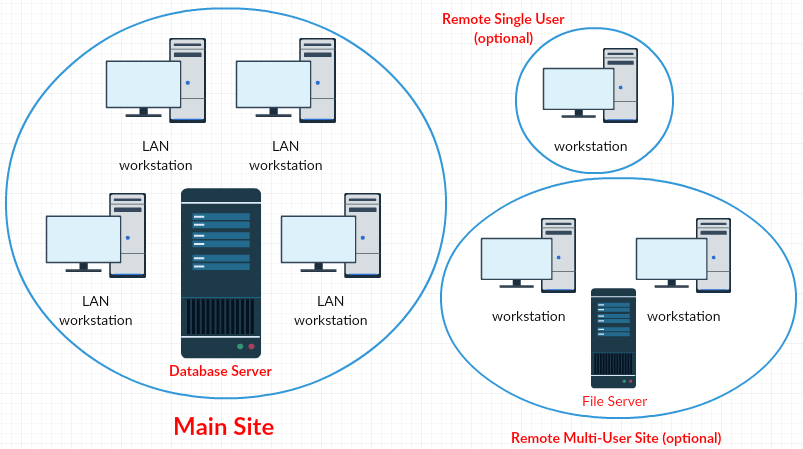
connections between remote users and the main database server use regular internet connections
Architecture
Referring to the above diagram, there are 3 components to the software architecture of the XV4 64-bit version of Q++Studio:
workstation |
Workstations are desktop PCs on which users use QuarkXPress or InDesign to create templates and non-dated information files in the QXP QuarkXPress or INDD InDesign format, and is also used to generate complete diaries and calendars. |
file server |
The file server is a desktop or server PC where QuarkXPress and InDesign templates and non-dated information files are saved (but on which neither QuarkXPress, nor InDesign, is installed). |
database server |
The database server is a desktop or server PC where the Q++Studio database is located (diary scripts, translations, holidays, slogans, astronomical data, ...). Multiple database servers can be inter-connected, or one database server can host multiple databases (one license is required for each database or database server). |
Depending of the configuration, these 3 components can each be on a separate computer, or they can all be on the same computer, or a combination thereof.
Possible Configurations
In practice, these 3 components can be mixed in various configurations:
Single User |
This is the simplest configuration, in which all 3 components are running on the same computer. |
Single Site |
This is the most common configuration, in which two or more PCs, acting as workstations, are connected via LAN to one PC, which is used as both file server and database server, and all PCs, workstations and servers are located at the same Main Site. |
Single Site with Remote Users |
This is a variation of the Single Site configuration where, additionally, remote single users, each working on a stand-alone PC, connect to the Main Site database server via the regular internet (WAN), with their individual PCs serving as both workstation and file server. |
Multiple Sites |
In this configuration, all 3 Q++Studio components are running on a different PC, and the 2 servers are located at different sites.
•The database server is located at the Main Site, where the majority of the workstations are also located, to benefit from the speed advantage of LAN connections versus WAN connections, and the main site's file server is located. •At the remote multi-user site, two or more PCs, acting as workstations, are connected via LAN to one PC, which is used as remote file server, and these workstations are also connected via the regular internet (WAN) to the database server at the Main Site. |
The reason why a file server is needed at every physical location, is that QuarkXPress and InDesign files can be very large, and are always saved entirely, as opposed to access to and from the database server, which can be fine-tuned to only read and write the changes that have occurred, if any. If QuarkXPress and InDesign worked as a database server does, one could ask to only open page 142 of a 384 page document, make changes to that page 142, and then send back only the modified page 142. Unfortunately this is not the case; even the most minute change to a QuarkXPress or InDesign file requires it to be fully re-saved.
The use of an EFS server on each file server alleviates the inconvenience that can arise with your QuarkXPress and InDesign files being located on different file servers.
Multiple Databases and Licenses
As mentioned above, multiple database servers can be inter-connected, or one database server can host multiple databases. In either case, one license is required for each database or database server.
To facilitate the exchange of work between databases, multiple license users benefit from script migration functions, which export or import scripts, as well as all their related data and templates.
Topic 181930, last updated on 02-Feb-2023